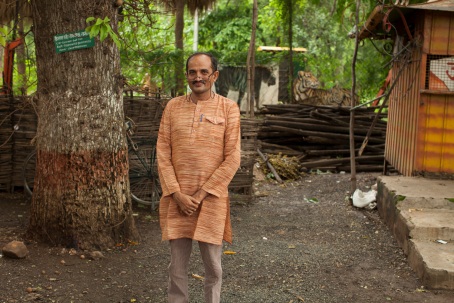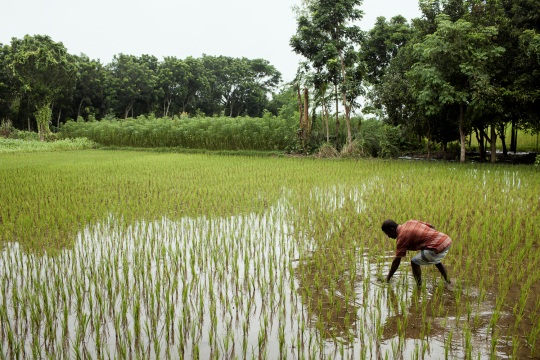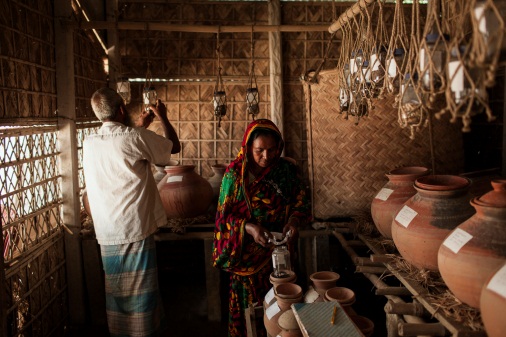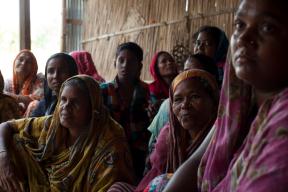
FREE THE SEEDS
Supporting Farmers in India and Bangladesh
The story of how the power of corporate seed companies impacts on ordinary people
Photography by Jordi Ruiz Cirera
Text by Global Justice Now
12th – 24th January 2017
The exhibition is free, and open during Chapel Café times: 10am – 4pm on weekdays & 10am – 3pm on Saturdays
India –the campaigner who wants to free the seeds
 Kapil Shah works for an organisation in Maharashtra called Jatan: Mission for Organic Farming. Kapil says that at the start farmers were happy with the introduction of Monsanto’s GM cotton. Good weather conditions and a high global price for cotton made it profitable for farmers to grow. So, many farmers stopped growing vegetables and other crops to just focus on cotton. After almost 8 years of growing GM cotton, farmers started to experience serious problems.
Kapil Shah works for an organisation in Maharashtra called Jatan: Mission for Organic Farming. Kapil says that at the start farmers were happy with the introduction of Monsanto’s GM cotton. Good weather conditions and a high global price for cotton made it profitable for farmers to grow. So, many farmers stopped growing vegetables and other crops to just focus on cotton. After almost 8 years of growing GM cotton, farmers started to experience serious problems.
He says pesticide use had increased to the same level, or even more, than before the introduction of Monsanto’s cotton. Pests have become more aggressive than they were before, with some even becoming resistant to pesticides, meaning that farmers are buying even more. Crops are becoming susceptible to diseases that previously were not a problem. Soil quality has deteriorated because GM cotton drains soil of its nutrients. The switch to cotton farming has also meant that less food was grown locally, leading to food shortages.
Kapil says the adoption of Monsanto’s cotton has contributed to farmer suicides as they often find themselves with unmanageable debt and ever increasing production costs Many farmers are now moving back to non-GM cotton. “There was a marriage with Monsanto but the honeymoon is over and now farmers are ready to get divorced.”
Kapil is hopeful for the future, predicting that more people will switch to organic agriculture and move away from chemicals. Kapil says there is a global fight against multinationals and their intensive, unsustainable agriculture.
India- The organic cotton factory
 A man works on a cotton weaving machine in Wardha, Maharasthra. The factory, located in a compound outside Wardha has only recently started working again after being abandoned for years.
A man works on a cotton weaving machine in Wardha, Maharasthra. The factory, located in a compound outside Wardha has only recently started working again after being abandoned for years.
It’s currently only used for the production of organic cotton products, ranging from raw cotton to finished clothes. The use of local, organic varieties of cotton for clothing is still not common, but the practice is growing as it has found a niche in Indian and global markets.
India –the village of farmer suicides
 A collective of women who work together on a cotton field in Bodan. In the town of Bodan in Maharashtra, 25 farmers have committed suicide in the last decade. Locals say that the deaths are linked to the extreme debt that has engulfed farmers after repeatedly paying for seeds and agricultural supplies to plant Monsanto’s GM cotton.
A collective of women who work together on a cotton field in Bodan. In the town of Bodan in Maharashtra, 25 farmers have committed suicide in the last decade. Locals say that the deaths are linked to the extreme debt that has engulfed farmers after repeatedly paying for seeds and agricultural supplies to plant Monsanto’s GM cotton.
From left to right: Baby Bai Viwodratnod, 52, Sampati Tara Songh, 58, Vimal Vishnu Chavan, 40, Anita Raju Pawn, 36. All four women lost their husbands to suicide after they became bankrupt and couldn’t cope with making repayments to moneylenders. They had taken out loans to pay for seeds and chemical fertilisers.

India -Organic farming: Boosting farmer’s incomes
 Anant Bhayar runs an organic farm in Katol, Maharashtra with his wife Varsha. They have had the farm for over 20 years, growing a wide range of crops including lentils, beans, cotton and fruit. They manage the farm on their own and hire labourers whenever needed, so the number of people working on the farm can range from 2 to 25.
Anant Bhayar runs an organic farm in Katol, Maharashtra with his wife Varsha. They have had the farm for over 20 years, growing a wide range of crops including lentils, beans, cotton and fruit. They manage the farm on their own and hire labourers whenever needed, so the number of people working on the farm can range from 2 to 25.
Anant is a staunch advocate of organic farming, and says it has been a very profitable enterprise. He switched to organic farming after a trial of GM cotton produced smaller yields and cost him more to produce than his organic crops.

India – GM Cotton and farmer suicides
 Baby Bai Baise, at her house in Hiwra, Maharashtra where she lives with her son, daughter-in-law and grandchildren. Her husband killed himself in 2007 by drinking sulphur poison. His crops were failing, and he was under a lot of pressure to pay off large loans he had taken out to pay for crop products.
Baby Bai Baise, at her house in Hiwra, Maharashtra where she lives with her son, daughter-in-law and grandchildren. Her husband killed himself in 2007 by drinking sulphur poison. His crops were failing, and he was under a lot of pressure to pay off large loans he had taken out to pay for crop products.
Baby Bai works as a GM cotton farmer, but sometimes grows soya bean. She has always planted cotton, but complains that the crop’s success is too dependent on good weather. She makes little profit out of the cotton crops, because almost all of it goes to paying off the loans she took in order to pay for Monsanto’s seeds.
Baby Bai told us that all the farmers in the area are in debt, and as a result many are suffering from constant stress. She said that three other men in her small village had also killed themselves in similar circumstances to her husband. Many farmers cannot access bank loans so depend on loans from informal lenders or relatives.
India – GM cotton: pesticides and problems

Anil Bhiwaji Kalg, 62, on his field where he grows Monsanto’s GM cotton alongside two hired labourers who spray the pesticides, Vilas Atram, 28 and Ashok Gatre, 35. Anil plants GM cotton, soya bean and lentils. Currently the cotton takes up more space on his farm, but his soya beans make him more money.
Anil complains that Monsanto’s cotton has become more expensive than other varieties and only gives him a small revenue. GM cotton only tackles one kind of pest, the Bollworm, but there are more pests that are not deterred by the GM crop, so he needs to spray other costly pesticides. He is currently in debt and will only make a profit if the crop is good. If the crop is not successful, he makes no money but still has the expenses. He lives in fear of not being able to pay back his loans, especially in the years where his crops have failed. If his debts increase he will need to sell his land and work as a labourer for other people.
Bangladesh –The introduction of GM aubergine
 Mahtab, 38, pictured with his wife Jahanara, 29, in the house in which they live, in Bangram, Pabna. Mahtab decided to plant GM aubergine after being chosen to participate in a government research trial. The aubergine strain was supposed to reduce pesticide use as it contains a chemical which makes the plant resistant to a particular pest. After a first round of trials, Mahtab’s GM aubergine crop resulted in low yields and less profits than if he had planted other crops. Mahtab opted out of future trials.
Mahtab, 38, pictured with his wife Jahanara, 29, in the house in which they live, in Bangram, Pabna. Mahtab decided to plant GM aubergine after being chosen to participate in a government research trial. The aubergine strain was supposed to reduce pesticide use as it contains a chemical which makes the plant resistant to a particular pest. After a first round of trials, Mahtab’s GM aubergine crop resulted in low yields and less profits than if he had planted other crops. Mahtab opted out of future trials.
Other farmers who live in nearby villages said that when they planted GM aubgerine it was protected against the one specific pest, but the presence of other pests increased. They had to spray the fields around four times a week, something they had never had to do before.
The plant known as Bt brinjal is the first GM food crop that is being approved for field cultivation in South Asia and is set to be commercially released after trials. Although the trials are being conducted by a government-run research centre, it is understood that Monsanto and its Indian partner Mahyco preserve all the intellectual property rights over GM aubergine.
Bangladesh – The community seed centre
 Zinnat Ali, 72, and Sureya Bagum, 40, at the village seed centre in Babupur village in Tangail district. Zinnat runs a local seed centre in his house, where he lives with his wife, daughter and grandson. This seed centre is a local offshoot from the regional seed centre in Tangail.
Zinnat Ali, 72, and Sureya Bagum, 40, at the village seed centre in Babupur village in Tangail district. Zinnat runs a local seed centre in his house, where he lives with his wife, daughter and grandson. This seed centre is a local offshoot from the regional seed centre in Tangail.
Zinnat regularly goes to the regional UBINIG Seeds Centre in Tangail together with two other farmers from his village. They take seeds from the local farms and swap them with others. They return to the village with new varieties every time. While in Tangail, they take time to discuss news with other farmers. On Zinnat’s last trip he donated his variety of bean seeds to the community centre, and picked up a new variety from the central hub at UBINIG.
Zinnat tells us that the commercial seeds he and his fellow farmers used to buy were more vulnerable to pests than the local varieties they are now using. He encourages other farmers to avoid using pesticides on their farms. In his community around 70% of farmers are now using organic methods. Corporate-controlled agriculture has meant that farmers have lost many seed varieties. But seed centres like these mean they can preserve their seeds without being dependent on commercial suppliers.
Bangladesh -UBINIG’s regional seed centre
 UBINIG is a Bangladeshi organisation that is famous for setting up one of the biggest collection of community seed banks in the world. UBINIG has run a community seed centre in Tangail since 1998. Here local farmers can leave their seeds and choose new ones, free of charge.
UBINIG is a Bangladeshi organisation that is famous for setting up one of the biggest collection of community seed banks in the world. UBINIG has run a community seed centre in Tangail since 1998. Here local farmers can leave their seeds and choose new ones, free of charge.
The centre encourages a decentralised seed system so that it doesn’t create farmer dependency on UBINIG or its seed centres. So in every village that uses the centre, there is also a seed hut where seeds are stored and preserved. These village seed stores exchange their seed varieties with the centre.
UBINIG consciously prioritises local seed varieties to ensure these are not lost. This careful seed management means that they have more than a thousand varieties of rice and more than 40 varieties of chillies alone.
Bangladesh – Woman and seeds meeting
 The women’s seeds group in Krishnupur is also a social centre for local women to meet and discuss agricultural issues alongside social concerns such as wedding dowries and early marriage, which they strongly oppose. Recently a 15 year old woman who was the granddaughter of one of the seeds group was going to get married, but the group managed to successfully intervene and prevent the marriage so she could continue studying.
The women’s seeds group in Krishnupur is also a social centre for local women to meet and discuss agricultural issues alongside social concerns such as wedding dowries and early marriage, which they strongly oppose. Recently a 15 year old woman who was the granddaughter of one of the seeds group was going to get married, but the group managed to successfully intervene and prevent the marriage so she could continue studying.
